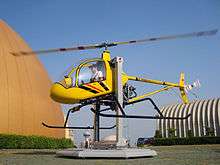Augusto Cicaré
| Augusto Ulderico Cicaré | |
|---|---|
| Born |
May 25, 1937 Polvaredas, Argentina |
| Residence | Saladillo, Buenos Aires |
| Nationality | Argentine |
| Fields | Engineering, aviation design |
| Known for | CH-7 Helicopter |
| Notable awards | Juan Manuel Fangio Prize |


Augusto Ulderico Cicaré (born May 25, 1937 in Polvaredas, Argentina) is an Argentine inventor, engineer and aviation designer.
At the age of 11, still in 5º grade, he builds his first four stroke engine that he used to drive a washing machine. In this same period he converts the engine of a car for the use of propane gas instead of fuel.[1] By age 15 he was constructing motorcycle engines.[2]
In 1958, despite having never seen an actual helicopter before, and knowing little of helicopter design,[3] Cicaré's first successful helicopter design, the CH-1, flew for the first time, with its designer as the test pilot,[2] teaching himself how to fly in the process.[3] The CH-1 was the first helicopter to have been designed and built in South America. By 1972, Cicaré was developing his third helicopter.[4]
In the late 1960s, Cicaré designed a V-4 engine for use in DKW automobiles, the engine being extensively tested by racing driver Juan Manuel Fangio.[2] A version of the engine for use in motorsports competition was also developed, but the closure of DKW resulted in the termination of the project.[2]
Cicaré continues to be active in aviation design, recent work including the Cicaré CH-10 and CH-11 ultralight helicopters, and the development of the Cicaré SVH-3 flight simulator, which was declared Argentina's national invention of the year in 1998.[2]
Awards
A 1987 design for a fuel injection pump for Diesel engines resulted in Cicaré being awarded the Juan Manuel Fangio Prize, the highest award for Argentine inventors.[2]
In 1970, Cicaré was declared to be one of the ten most outstanding young men of Argentina, and in 1996 he was named as a Friend of the Argentine Air Force.[2] Cicaré also received an honorary Air and Space Engineer degree in 1997 from the Professional Council of Air and Space Engineering.[2]
In 1999, a roundabout in Saladillo, Argentina was named in Cicaré's honour.[2]
See also
- Cicaré Helicópteros
- Cicaré CK.1
- Cicaré CH-12
- Cicaré CH-16
- Heli-Sport CH-7
- Revolution Helicopter Corporation
References
- Notes
- ↑ Merola, Daniel (2015-06-08). "El mago de los helicópteros inventa y fabrica en Saladillo". ABC Saladillo. Archived from the original on 2016-03-04. Retrieved 2015-09-05.
- 1 2 3 4 5 6 7 8 9 Augusto Cicaré Archived October 2, 2011, at the Wayback Machine., Cicaré Helicopters. Accessed 2010-10-28.
- 1 2 Rotary Revolution Flightglobal.com, 22 Oct 2000. Accessed 2010-10-28.
- ↑ Jane's 1971–1972, p. 3
- Bibliography
- Taylor, John W.R. (ed.) Jane's All The World's Aircraft 1971–1972. London: Sampson Low Marston & Co, 1972. ISBN 978-0-354-00094-9.